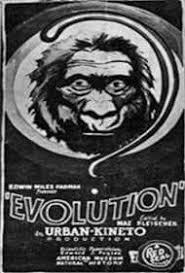“Evolution” was released in 1923 and was directed by Ovide Decroly, Dave Fleischer and Max Fleischer. I’ve also seen where direction was also credited to Raymond L. Ditmars. It is an American Belgium silent documentary short, approximately 41 minutes long.
The film was initially released by Urban Motion Pictures under the title “Evolution: From the Birth of the Planets to the Age of Man”. Urban Motion Pictures went bankrupt in 1924. I believe the Fleischers re-released in 1925 as “Evolution” or “Darwin’s Theory of Evolution” or “Was Darwin Right?” with some edits under their Red Seal Pictures. Reportedly the name change, and some of the added scenes, were to capitalize on the “Scopes Monkey Trial” that was in the news at the time.
In 1950 the Fleischers did some more updates to the film and added some footage of modern trains and airplanes, but the film was still silent. The modern (1950) portions of the film were added using sound stock footage. This caused the optical soundtrack to show on the left side of the screen which can be seen in the copy I have of the film. Most of the copies of the film still in existence are the 1950 version.
The film starts out talking about man’s accomplishments. It then goes back in time and discusses the creation of the planets. It then talks about the beginnings of life on Earth and brings the timeline forward talking about various animals both extinct and those still in existence. The film is a mix of live action, stop motion and drawn animation. Of course, some of the information in the short is outdated or even downright incorrect, such as the debunked Piltdown Man. It is a conglomerate of images and sounds that reminds me of one of Roger Corman’s cut and paste films. Still, it’s an interesting little film that reflects not only our early view of creation but also a tiny look at early filmmaking.
Some of the dinosaur scenes are still photos taken from Carl Hagenbeck’s Zoo in Hamburg, Germany. Some are stop motion views that were done by Willis O’Brien for the film “The Ghost of Slumber Mountain” 1918.


